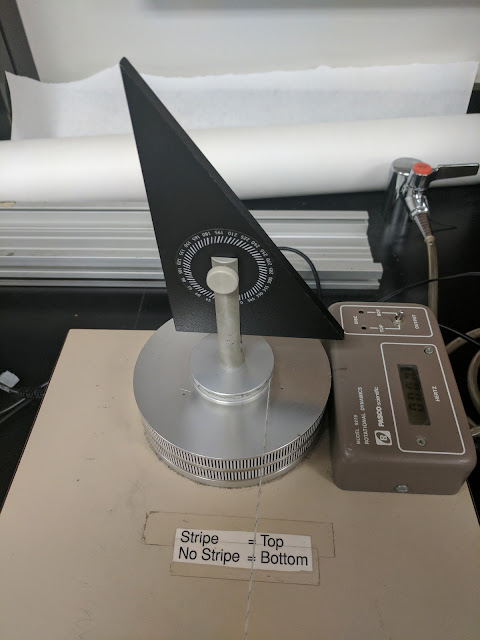Lab 17: Moment of Inertia of a Right Triangle
Joel Cook
Nina Song
Eric Chong
Lab finished May 22, 2017
In this lab, we were tasked with finding the moment of inertia of a triangular metal plate using a rotation apparatus. In theory, by using the moment of inertia for a triangle rotating about one edge, and the parallel axis theorem, we can calculate the moment of inertia when the axis of rotation is about the center of mass. We will be verifying this theory by measuring the angular acceleration of the system with and without a triangular plate installed to calculate the moment of inertia of the plate.
Theory: Since there is going to be friction in the system, the magnitude of the angular acceleration as the mass ascends will not be equal to the magnitude as the mass descends. To account for this, we will use the equation for moment of inertia using average angular acceleration that was derived in Lab 16: Angular Acceleration.
I(disc) = m*g*r - m*r^2
( |α(up)|+|α(down)|)
2
As previously derived, the moment of inertia for a triangle rotating about the center of mass,
I = 1/18 * mass * base^2
Procedure:
For this experiment, we used the apparatus shown below:
Air flows between the rotating discs to reduce the friction and allow the system to rotate freely about the axis. The hanging mass supplies the tension force on the disc through the string which causes the disc to rotate. We connected the apparatus to Logger Pro and a laptop to take readings for the angular acceleration of the system as the discs rotate clockwise and counterclockwise. The string was wrapped around the pulley and the mass was released to begin rotating the system. Measurements were taken while the system was rotating.
After we measured the angular acceleration for the system without the triangular plate in place, we mounted the plate as shown below:
The triangular plate has a mounting hole located 1/3 of the width and length of the plate. For a right triangle of uniform density, the center of mass is 1/3 from the perpendicular edges of the triangle, for both the height and width. Marks on the triangle allow for measuring the angle at which the plate is mounted. The plate was mounted exactly perpendicular for both cases.
The last portion involved taking measurements again with the plate mounted as shown below:
Data/Analysis:
Mass hanging: 25g
Mass of plate: 456g
Vertical base length: 98.2mm
Horizontal base length: 149.1mm
Radius of disc: 0.02485m
The following data was graphed during the experiment. For our purposes, we analyzed the graph of velocity vs time for each trial. By taking a linear fit of the angular speed vs time graph, we were able to calculate the angular acceleration of the system as it rotates. The graphs show the acceleration both in clockwise and counterclockwise direction.
The first graph pictured shows the angular acceleration for the apparatus with no plate attached. The acceleration recorded was -6.548 rad/s^2 and 5.855 rad/s^2, respectively.
The second graph pictured shows the angular acceleration for the apparatus with the triangular plate mounted vertically. The acceleration recorded was -5.179 rad/s^2 and 4.516 rad/s^2, respectively.
The last graph pictured shows the angular acceleration for the apparatus with the triangular plate mounted horizontally. The acceleration recorded was -4.102 rad/s^2 and 3.648 rad/s^2, respectively.
By calculating the moment of inertia of the system without the plate and with the plate and subtracting the results, we can find the moment of inertia for the triangular plate in each mounting configuration.
The moment of inertia for the apparatus without the plate mounted:
I = (0.025 kg)*(9.8 m/s^2) (0.02485 m) - (0.025 g)*(0.02485 m)^2 = 0.00097 kgm^2
(5.855 + 6.548) rad/s^2
2
Moment of inertia for system with vertically mounted triangle = 0.000124 kgm^2
Moment of inertia for system with horizontally mounted triangle = 0.000156 kgm^2
To find the moment of inertia for just the triangular plate we take the difference as described previously:
Vertical mounting:
0.000124 - 0.00097 = 0.00027 kgm^2
Horizontal mounting:
0.000156 - 0.00097 = 0.00059 kgm^2
These values can be compared against the moment of inertia of triangle with axis through the center of mass calculated from the equation:
I(cm) = 1 *Mass*Base^2
18
Vertical: I = 1 * (0.456)*(0.0982)^2 = 0.000244 kgm^2
18
1 - 0.000244/0.00027 *100 = 9.63% difference
Horizontal: I = 1 * (0.456)*(0.1491)^2 = 0.00056 kgm^2
18
1 - 0.00056/0.00059 *100 = 5.08% difference
Conclusion:
Overall, the lab was successful. We were able to show that calculating the moment of inertia of the apparatus with and without the triangular plate and subtracting the two gave us the moment of inertia of the triangular plate. We confirmed that the value obtained experimentally is within 10% of the value obtained theoretically. As is true in any experiment, there are errors and uncertainties in the lab. The tools used to measure lengths and masses could be more precise, there is going to be friction between the rotating discs, and the pulley is not massless or frictionless. We attempted to mitigate these factors as much as possible by using the most precise equipment available to us and taking friction into account. Our results suggest that our efforts were successful.






